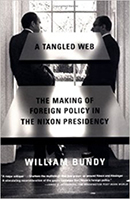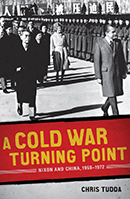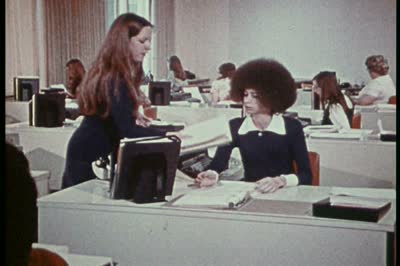Liberating Half the Nation
By Katie Sundstrom

Winifred D. Wandersee
Winifred D. Wandersee was a well-known history professor who taught at Hartwick College where she founded a Women’s Studies and Gender Program. Focusing her studies largely on women throughout history, her education motivated her to detail the happenings of an era of profound revolution.





America experienced an era of revolution in the 1970s that challenged previous traditional views on the roles and rights of women. In Winifred D. Wandersee’s On the Move: American Women in the 1970s, this transition to a new form of thinking is detailed through the chronological history of American women and their contributions to the movement that molded the decade into one of profound revolutionary change. Intending to define a part of “history that is still alive and still a part of every woman”, Wandersee goes into depth to describe the distinguishing characteristics of the rise of feminism and the development of the Women’s Liberation Movement.1 On the Move outlines the major moments of the 1970s while providing a story of the smaller and more intricate details that truly made the movement the powerful force it was.
Winifred D. Wandersee’s On the Move: American Women in the 1970s begins by setting the stage for the detailing of a decade of revolution by providing the history of the events that came before it. While the 1970s allowed for a large amount of change in women’s rights and liberation, much of the late 1960s played a huge role in allowing this all to take place. Starting off the work with a chapter titled “Good-Bye to All That: From Revolution to Liberation”, Wandersee provides a clear image to what the beginning section of this book is all about.2 Although issues of inequality have been a part of America’s history since before its establishment as a country, the fight for women’s rights did not truly begin to gain force until the 1960s. Focusing on acts such as the 1963 Equal Pay Act and 1964 Civil Rights Act, Wandersee writes of the events that laid the foundation for the Women’s Liberation Movement. Claiming that “one major reform that occurred in the 1960s that was to have an impact on the women’s movement of the seventies was political party reform,” Wandersee allocates a large portion of the beginning of this book to this type of change.3 The rise of women’s organizations such as the National Organization for Women and the Sisters in the Underground Weather Organization developed early on and made way for the many movements to come, along with their powerful leaders. The development of affirmative action in the 1960s also encouraged the increased participation of women and youth in the movement for women’s rights. While the large span of issues of women’s rights led to the development of many different viewpoints, women all came together at the end of the 1960s with an understanding that there was an overwhelming need to “’change the way the world operate[d] [rather] than integrate women into that system.’”4 As issues of women’s rights were slowly dragged into the spotlight of American society, the foundation for this new form of thinking created in the 1960s played a strong part as a platform for the era of revolution to come.
While several small steps towards women’s liberation were cautiously made in the 1960s, leaps and bounds were victoriously made throughout the 1970s. After Wandersee details the events leading up to the rise of feminism and women’s liberation, the book transitions its focus to that of the effects of the movement and the different perspectives on the proper way to bring about change. Due to the alarming increase in attention to women’s rights, the movement splintered off into various groups and ideologies, all fighting for the same ultimate cause, but in several different ways. As the decade began, it was rapidly marked by a “proliferation of rape crisis centers, health collectives, battered women’s centers, child-care centers” and many other programs created to benefit women and their fight for freedom.5 Not only does Wandersee focus on these societal changes that altered the daily lives of women, but also on the broader definition of what the 1970s made being a woman all about. As of the 1970s, to be a woman typically referred to “outrageous, audacious, courageous, or willful behavior” paired with the desire of “wanting to know more and in greater depth than is considered ‘good’ for one.”6 Detailing the early and rapid take-off of the Women’s Liberation Movement in the 1970s, Wandersee dedicates the beginning section of On the Move to the initial changes and reactions that resulted from the rise of the fight for women’s rights.
After creating a clear outline for the major organizations and movements that began to arise along with the women’s movement, Wandersee goes further into depth to describe the activists and leaders that made many of these movements possible. Women such as Betty Friedan, Judith Long Laws, Joan Roberts, Bernice Sandler, and Jane Alpert played major roles in the organization of women’s groups dedicated to equality and an end to discrimination. As the Women’s Liberation Movement rapidly gained force, “the early seventies [were] characterized by an enthusiasm, an excitement that was unlike anything that had gone before in the history of women.”7 Encouraged by the desire for change and the success of the movements taking place, feminism in the 1970s hit a growth spurt that led to overwhelming support and widespread dedication to women’s rights. What originally began as a small grass roots movement developed into a nationwide fight for change, and the broad topic of women’s rights was narrowed down into specific issues such as rape, lesbianism, women’s education, and much more.
As the Women’s Liberation Movement moved towards its peak, many changes were successfully made to increase equality throughout America. While women still had a long way to go, Wandersee’s On the Move comes to a close by detailing the winding down of the forceful movement and its many successes. At the end of the decade, “women’s public image was brighter, more visible, and more independent.”8 While Wandersee does not turn a blind eye to the fact that women’s liberation still had a very long way to go, the work’s end is dedicated in large to the positive that resulted from the movement and less so on the negative. Towards the end of the seventies, the majority of organizations for the Women’s Liberation Movement had already been established, and many of the main and most drastic changes had already taken place. As the excitement brought on by early success began to decline, the splintering off of separate ideals led to conflict within the women’s movement. While arguments arose over what right of women should be the collective focus of the movement, popular support began to decline for the subject. However, Wandersee makes sure to provide an overall and lasting impression of the “exhilarating combination of sisterhood, love, empathy, and compassion, offering all the best potential of the women’s movement.”9
While Wandersee’s On the Move: American Women in the 1970s focuses largely on detailing the chronological history of the movement for women’s rights that shaped America during the decade, Wandersee also intends to depict the overwhelming political and societal effects it had on American culture. Although the movement was centered on equality for women, it made far more contributions than just an increase in women’s rights. Wandersee also shows the side of the Women’s Liberation Movement that led to a drastic change in the way of thinking that molded America into a nation of new ideas. Throughout On the Move, Wandersee clearly shows that the impact of the rise of feminism did far more than bring the topic of civil rights into the light; it catapulted a generation of traditional conservatives into an era of change. The Women’s Liberation of the Movement of the 1970s took an issue disregarded by many as trivial or unimportant, and blew it up so big it instigated a snowball effect that affected an entire nation. Wandersee begins her work by detailing the events of the 1960s that led up to the fight for women’s rights, fills the bulk of it with the improvements that occurred in the 1970s, and brings the book full circle in the end to describe how the bounds and leaps of the seventies have set the stage for the world of today. Wandersee claims that “whether the issue is work, education, sexuality, motherhood, family life, friendship, or autonomy, it has been redefined so that for many women the problem has become choice rather than channeling.”10 Although a large portion of On the Move is dedicated to relaying the history of American women in the seventies, Wandersee’s true purpose in publishing this work is to bring to light the profound impact the women’s right movement had on the generations of the past, as well as the lasting impact it still has on the generations of today.
A large part of Wandersee’s On the Move was significantly impacted by her own personal beliefs and career path, as well as the time period she grew up in and when this work was written. Born in 1940, Wandersee was raised through an era that experienced a large number of changes in civil rights and lived during the 1970s when many of these changes were focused around women’s rights. No doubt impacted by being alive during this period, Wandersee wrote this book less than a decade after the end of the seventies, and pays close attention to a time period she can easily relate to. In the preface of her book, she writes of how she chose a time and topic that were both “challenging and exciting for [her].”11 Wandersee excelled as a history professor at Hartwick College, and was responsible for the creation of the Women’s Gender Studies Program. While it is easy to conclude that women’s rights and their history was important to her, it is also evident through her choice to write On the Move as a contribution to a series of books written by various authors on American Women in the Twentieth Century. Influenced by her experience of living through this decade of change and centering her career path on American history and women’s studies, Wandersee wrote On the Move with clear intentions to communicate the importance of the history of women and its lasting effect on America.
In Lois W. Banner’s review of Wandersee’s On the Move, Banner critiques Wandersee’s lack of attention to certain details of the women’s movement of the 1970s, but compliments the work for being both “intelligent and interesting.”12 Noting the liveliness and excitement brought about by Wandersee’s interest in the work, Banner applauds Wandersee’s ability to maintain an air of importance in her description of the subject. The review criticizes how On the Move appears to be a continuation of the typical structure for this historical period and fails to “challeng[e] male historians with new turning points and main events.”13 Banner implies that Wandersee falls flat in providing a dimension of the seventies that differs from what has already been said. Janet Fletcher’s review of Wandersee’s same work takes a different perspective. While Banner claims the book is missing certain details, Fletcher describes it as “comprehensive to a fault, sometimes growing dull.”14 Fletcher’s review showcases On the Move as a positive and analytical recollection of an important period of history. Both reviews appear to agree on the significance of the women’s liberation movement, but each has its own unique take on Wandersee’s writing. While the book is spoken of as an overall success, Banner and Fletcher both point out areas with possible room for improvement.
Wandersee’s On the Move tells a detailed history of American women in the 1970s that provides a lot more than just a mere explanation of the decade’s events. While parts of the work focus almost too intensely on names and dates, it still provides a consistently fascinating history of the many movements for women’s rights that ultimately shaped society. The contrast of women’s rights in the seventies with those of women today is so drastically different it is almost impossible to wrap one’s mind around how much has changed. Wandersee does a detailed job of providing every bit of information necessary for one to understand the era, along with the perfect amount of personal opinion. The way the work is written makes it difficult not to become emotionally invested in the fight for women’s rights that drastically affected the 1970s. As Wandersee writes about the “successful woman of the late seventies envisioned as young and beautiful, slender … and just feminist enough to want her own way,” the resemblance of how the media portrayed women thirty years ago with how women are portrayed today is shocking and makes the book all the more relatable.15 While Wandersee does a more than sufficient job in detailing the events of the Women’s Liberation Movement in the 1970s, the work finds its true power in the way it communicates the striking similarities and differences of an era of change that occurred long ago and the society of America today.
While On the Move provides a detailed history of the women’s movement, Wandersee’s larger purpose in the production of this work is to communicate the importance of the era of change that took place during the 1970s. Wandersee notes the slight distrust in the government and consistent political change of the decade, but focuses mainly on the seventies as a time of vast improvement rather than severe crisis. On the Move begins with an explanation of the events that led up to the full force Women’s Liberation Movement of the 1970s. Focusing on the foundation for the changes that took place in the seventies, Wandersee blurs the border between the decades. While not explicitly stating that the 1970s were a continuation of the 1960s, the unclear cut between the two time periods illustrates Wandersee’s view on how the sixties and its ideology bled clearly into the seventies. Throughout her writing, Wandersee refers to the 1960s as the “older branch of feminism”, hinting at how the two decades are connected.16 Wandersee clearly communicates throughout On the Move that the 1960s served as the foundation for an era of improvement in the 1970s.
Winifred D. Wandersee’s On the Move: American Women in the 1970s provides an in depth history of an era of change with long lasting effects still present today. Wandersee communicates the importance of the history itself while sharing a unique perspective on a topic that is still controversial in many ways. While she touches upon the importance of many key movements of the decade, her main focus is summarized by one of her concluding sentences: “The legacy of that decade of women on the move has shaped the politics and culture of the last years of the century to an extent unrivaled by any social movement.”17 But Wandersee’s On the Move tells far more than a story of a decade; it provides a window into the world of the past and a mirror for the world of the present.
Footnotes:
- Wandersee, Winifred. On the Move: American Women in the 1970s. G.K. Hall & Co.: Twayne Publishers, 1988. 1.
- Wandersee, Winifred. 1.
- Wandersee, Winifred. 3.
- Wandersee, Winifred. 42.
- Wandersee, Winifred. 56.
- Wandersee, Winifred. 73.
- Wandersee, Winifred. 120.
- Wandersee, Winifred. 173.
- Wandersee, Winifred. 195.
- Wandersee, Winifred. 201.
- Wandersee, Winifred. vii.
- Banner, Lois W., NWSA Journal, Vol. 1. Johns Hopkins University Press Stable, 1989. 739.
- Banner, Lois W. 740.
- Fletcher, Janet. American Library Association, Booklist Review.
- Wandersee, Winifred. 173.
- Wandersee, Winifred. 37.
- Wandersee, Winifred. 202.




4 - 4
<
>